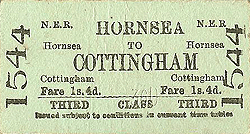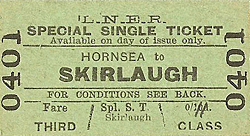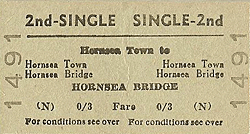| Notes: Hornsea Town was the terminus of the Hull and Hornsea
Railway, located around 100 yards from the sea. The fine station
buildings were designed by Rawlins Gould, originally a canopy
covered the main platform and track , being attached to the
station buildings and supported on cast iron columns on the
outer side. The building is similar in appearance to |
 |
York and
North Midland Railway structures, no doubt due to the fact that
Gould had previously been employed by George Townsend Andrews,
the YNMR architect. There was one long main platform adjacent
to the buildings, with an equally long island platform for excursions.
The station was opened as Hornsea with Town added from 25.9.1950.
The station stood derelict but intact until 1987 when work
began to convert the station buildings into housing; the excursion
platforms were removed and new houses built on the site. A new
access road was built on the trackbed.
BRIEF HISTORY OF THE HULL &
HORNSEA RAILWAY
A line connecting the Hull-Scarborough branch at Arram to a
site near Hornsea Mere had been proposed in 1846/7 by the York
and North Midland Railway but never built due to the downfall
of chairman George Hudson amidst a financial scandal.
A new line connecting Hull and Hornsea was promoted by Hornsea
resident and Hull timber merchant Joseph Armytage Wade, the
aim of such a line being to develop Hornsea as a fashionable
Victorian seaside resort.
 |
The first sod was turned by Wade on 8.10.1862. Problems were
encountered during construction due to the nature of the local
soil; there were further issues with poor workmanship and materials
used by the contractors. A late change of plan saw the line
extended from the proposed terminus at Hornsea Bridge to the
seafront; this meant construction of an |
embankment which required
the ground to be piled adding substantially to the already escalating
construction costs.
| Opened on 28.3.1864, the line ran in a fairly direct North
Easterly direction from Hull, the original Hull terminus was
Wilmington station, though after 1st June 1864 trains ran via
the Victoria Dock branch into Hull's Paragon station. Due to
lower than expected receipts and consequent financial difficulties,
the Hull and Hornsea Railway merged with the North Eastern |
 |
Railway
on 16.7.1866.
 |
The line was constructed as a single track but was doubled
throughout in the early 1900s. Diesel railcars were introduced
from 71.1957 and operated local services from that date. Centralised
Traffic Control (automated signaling and level crossings) was
proposed in the early 1960's, but this was overtaken by the
'Beeching Report'. Closure to passengers came |
on 19.10.1964,
with Goods services to Hornsea Bridge continuing until 3.5.1965.
Tickets from Michael Stewart
Today, the trackbed of the railway forms the 'Hornsea
Rail Trail', also part of the 'Trans
Pennine Trail'- the majority of station buildings still
exist and the trackbed is virtually complete throughout.
Further reading 'The
Lost Railways of Holderness' by Peter Price (Hutton Press)
ISBN 0 0907033 86 5. Route map drawn by Alan Young.
To see the other
stations on the Hull & Hornsea Railway click on the station
name: Sutton-on-Hull,
Swine, Skirlaugh, Ellerby
(1st station),
Ellerby (2nd station), Whitedale, Sigglesthorne,
Wassand & Hornsea
Bridge
|






10.jpg)
 Home
Page
Home
Page













